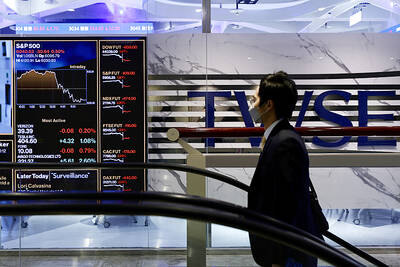Innolux Corp (群創) is supporting Sharp Corp’s construction of its first organic light-emitting diode (OLED) display production line, which might open the door for joint investments in future OLED plants to avoid investment overlap, a company executive said yesterday.
Innolux has been working with Sharp to accelerate the commercialization of OLED technology, after the Osaka-based company became a subsidiary of Hon Hai Precision Industry Co (鴻海精密) via a share sale deal worth US$3.5 billion in April last year.
Innolux is Hon Hai’s Taiwan-based LCD display manufacturing arm.
Integrating group resources, Sharp and Innolux engineers jointly worked on research and development at Innolux’s fab before Sharp started its own G4.5 OLED fab, Hon Hai Technology Group (鴻海科技集團) display consultant Tuan Hsing-chien (段行建) said at a news conference yesterday.
At that time, Innolux made faster progress with an experimental OLED line, while Sharp was in the early stages of developing expensive OLED technology, Tuan said.
“We plan to send about 10 Innolux employees from the company’s OLED operation to join Sharp’s new G4.5 [OLED] plant later this month, or in May,” Tuan said.
“This will be the first phase,” for Innolux to participate in Sharp’s OLED plant, Tuan added.
When asked if Innolux planned to build its own OLED plant, Tuan said: “There is no need for Innolux to repeat what Sharp has done.”
“The companies could jointly build an OLED plant. There is no need for all of us to build our own fabs. There is no need for an overlap,” Tuan said.
For the same reason, Innolux might not have to build its own G10 plant to produce larger displays, Tuan said, adding that no Taiwanese companies can afford to build such a plant without government support.
OLED technology requires a massive capital investment and has a higher technological barrier than thin-film-transistor liquid-crystal-display technology.
Sharp has a good chance of beginning to operate its own G4.5 OLED fab next year, Tuan told reporters in May last year, when he accepted the new job at Hon Hai.
Tuan is a former chairman and CEO of Innolux.
He also said at the time that “OLED [technology] is a major consideration for Hon Hai’s investment in Sharp,” as Apple Inc, Hon Hai’s biggest client, was reportedly shifting to OLED displays from low-temperature polycrystalline silicon displays for next-generation iPhones.
Except OLED technology, Innolux and Sharp are complementary in terms of indium-gallium-zinc-oxide technology, panel capacities and factory management skills, Tuan said.
Innolux shares rose 0.68 percent to NT$14.8 in Taipei trading yesterday, outperforming the TAIEX, which gained 0.31 percent.

SELL-OFF: Investors expect tariff-driven volatility as the local boarse reopens today, while analysts say government support and solid fundamentals would steady sentiment Local investors are bracing for a sharp market downturn today as the nation’s financial markets resume trading following a two-day closure for national holidays before the weekend, with sentiment rattled by US President Donald Trump’s sweeping tariff announcement. Trump’s unveiling of new “reciprocal tariffs” on Wednesday triggered a sell-off in global markets, with the FTSE Taiwan Index Futures — a benchmark for Taiwanese equities traded in Singapore — tumbling 9.2 percent over the past two sessions. Meanwhile, the American depositary receipts (ADRs) of Taiwan Semiconductor Manufacturing Co (TSMC, 台積電), the most heavily weighted stock on the TAIEX, plunged 13.8 percent in

A wave of stop-loss selling and panic selling hit Taiwan's stock market at its opening today, with the weighted index plunging 2,086 points — a drop of more than 9.7 percent — marking the largest intraday point and percentage loss on record. The index bottomed out at 19,212.02, while futures were locked limit-down, with more than 1,000 stocks hitting their daily drop limit. Three heavyweight stocks — Taiwan Semiconductor Manufacturing Co (TSMC, 台積電), Hon Hai Precision Industry Co (Foxconn, 鴻海精密) and MediaTek (聯發科) — hit their limit-down prices as soon as the market opened, falling to NT$848 (US$25.54), NT$138.5 and NT$1,295 respectively. TSMC's

ASML Holding NV, the sole producer of the most advanced machines used in semiconductor manufacturing, said geopolitical tensions are harming innovation a day after US President Donald Trump levied massive tariffs that promise to disrupt trade flows across the entire world. “Our industry has been built basically on the ability of people to work together, to innovate together,” ASML chief executive officer Christophe Fouquet said in a recorded message at a Thursday industry event in the Netherlands. Export controls and increasing geopolitical tensions challenge that collaboration, he said, without specifically addressing the new US tariffs. Tech executives in the EU, which is

In a small town in Paraguay, a showdown is brewing between traditional producers of yerba mate, a bitter herbal tea popular across South America, and miners of a shinier treasure: gold. A rush for the precious metal is pitting mate growers and indigenous groups against the expanding operations of small-scale miners who, until recently, were their neighbors, not nemeses. “They [the miners] have destroyed everything... The canals, springs, swamps,” said Vidal Britez, president of the Yerba Mate Producers’ Association of the town of Paso Yobai, about 210km east of capital Asuncion. “You can see the pollution from the dead fish.